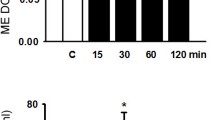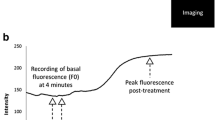Abstract
Nitric oxide is an unconventional transmitter since it is not transported and released by exocytosis. In the pituitary gland, nitric oxide is locally synthesised by gonadotroph and folliculo-stellate cells. Dopamine, the principal central inhibitory signal in prolactin release, may exert its inhibitory effects by stimulation of nitric oxide production. However, the effects of dopaminergic modulation on nitric oxide-producing pituitary cells have not been analysed. Therefore, we examined the effects of intraventricular administration of the dopamine antagonist haloperidol (40 μg) on the pituitary expression of neuronal nitric oxide synthase (nNOS) in male adult rats. In untreated and control animals, nNOS-positive cells were very similar. Two types of nNOS-positive cells appeared in the pars distalis: round or polygonal cells and stellate cells. Although some isolated cells were found, the nNOS-positive cells commonly appeared grouped in clusters close to blood vessels. nNOS immunoreactivity appeared as a uniform staining throughout the cytoplasm, including cell prolongations. The number and size of nNOS-expressing cells in the pituitary gland decreased significantly after treatment with haloperidol (p<0.01). To evaluate the potential direct effect of dopamine on pituitary cells, pituitary monolayer cultures were treated with dopamine during a time-course of 12 h. Our in vitro studies revealed that dopamine increases the percentage of nNOS-positive cells and augments cellular area (p<0.05). These results demonstrate that: (1) treatment of rats in vivo with a dopamine antagonist significantly decreases expression of nNOS in the pituitary and (2) in vitro dopamine exerts a direct effect on pituitary cultures by increasing nNOS-positive cells. Thus, these findings suggest that dopamine may function as a physiological stimulator of nNOS expression in the rat pituitary gland.






Similar content being viewed by others
References
Alonso JR, Arévalo R, Weruaga E, Porteros A, Briñón JG, Aijón J (2000) Comparative and developmental neuroanatomical aspects of the nitric oxide system. In: Steinbusch WM, De Vente J, Vincent SR (eds) Functional neuroanatomy of the nitric oxide system. Handbook of chemical neuroanatomy (A. Björklund, T. Hökfelt, eds). Elsevier, Amsterdam, pp 51–109
Bredt DS, Hwang PM, Snyder SH (1990) Localization of nitric oxide synthase indicating a neural role for nitric oxide. Nature 347:768–770
Bult H, Boeckxstaens GE, Pelckmans PA, Jordaens FH, van Maercke YM, Herman AG (1990) Nitric oxide as an inhibitory non-adrenergic non-cholinergic neurotransmitter. Nature 345:346–347
Bunzow JR, Van Tol HH, Grandy DK, Albert P, Salon J, Christie M, Machida CA, Neve KA, Civelli O (1988) Cloning and expression of a rat D2 dopamine receptor cDNA. Nature 336:783–787
Ceccatelli S, Hulting AL, Zhang X, Gustafsson L, Villar M, Hökfelt T (1993) Nitric oxide synthase in the rat anterior pituitary gland and the role of nitric oxide in regulation of luteinizing hormone secretion. Proc Natl Acad Sci USA 90:11292–11296
Chen L, Sakai T, Sakamoto S, Kato M, Inoue K (1999) Direct evidence of gonadotropin-releasing hormone (GnRH)-stimulated nitric oxide production in the L beta T-2 clonal gonadotropes. Pituitary 2:191–196
Chiodera P, Volpi R, Coiro V (1998) Involvement of nitric oxide in vasoactive intestinal peptide-stimulated prolactin secretion in normal men. Metabolism 47:897–899
Cuttica CM, Gisuti M, Bocca L, Sessarego P, De Martini D, Valenti S, Spaziante R, Giordano G (1997) Nitric oxide modulates in vivo and in vitro growth hormone release in acromegaly. Neuroendocrinology 66:426–431
Dal Toso R, Sommer B, Ewert M, Herb A, Pritchett DB, Bach A, Shivers BD, Seeb PH (1989) The dopamine D2 receptor: two molecular forms generated by alternative splicing. EMBO J 8:4025–4034
Duvilanski BH, Zambruno C, Seilicovich A, Pisera D, Lasaga M, Díaz MC, Belova N, Rettori V, McCann SM (1995) The role of nitric oxide in control of prolactin release by adenohypophysis. Proc Natl Acad Sci USA 92:170–174
Duvilanski BH, Zambruno C, Lasaga M, Pisera D, Seilicovich A (1996) Role of nitric oxide/cyclic GMP pathway in the inhibitory effect of GABA and dopamine on prolactin release. J Neuroendocrinol 8:909–913
Ferrini M, Wang C, Swerdloff RS, Sinha Hikim AP, Rajfer J, Gonzalez-Cadavid N (2001) Aging-related increased expression of inducible nitric oxide synthase cytotoxicity markers in rat hypothalamic regions associated with male reproductive function. Neuroendocrinology 74:1-11
Foerstermann U, Boissel JP, Kleinert H (1998) Expressional control of the “constitutive” isoforms of nitric oxide synthase (NOS I and NOS III). FASEB J 12:773–790
Garrel G, Lerrant Y, Siriostis C, Berault A, Magre S, Bouchaud C, Counis R (1998) Evidence that gonadotropin-releasing hormone stimulates gene expression and levels of active nitric oxide synthase type I in pituitary gonadotrophs, a process altered by desensitization and, indirectly, by gonadal steroids. Endocrinology 139:2163–2170
Giros B, Sokoloff P, Martres MP, Riou JF, Emorine LJ, Schwartz JC (1989) Alternative splicing directs the expression of two D2 dopamine receptor isoforms. Nature 342:923–926
Gobbetti A, Zerani M (1998) Nitric oxide mediates gonadotropin-releasing hormone effects on frog pituitary. J Neuroendocrinol 10:407–416
Grodum E, Andersen M, Hangaard J, Koldkjaer O, Hagen C (1998) Lack of effect of the dopamine D1 antagonist, NNC 01–0687, on unstimulated and stimulated release of anterior pituitary hormones in males. J Endocrinol Invest 21:291–297
Haluzik M, Nedvídková J, Kopský V, Jahodová J, Horejsí B, Schreiber V (1998) The changes of the thyroid function and serum testosterone levels after long-term L-NAME treatment in male rats. J Endocrinol Invest 21:234–238
Herbison AE, Simonian SX, Norris PJ, Emson PC (1996) Relationship of neuronal nitric oxide synthase immunoreactivity to GnRH neurons in the ovariectomized and intact female rat. J Neuroendocrinol 8:73–82
Hileman SM, Jackson GL (1999) Regulation of gonadotrophin-releasing hormone secretion by testosterone in male sheep. J Reprod Fertil Suppl 54:231–242
Hölscher C (1997) Nitric oxide, the enigmatic neuronal messenger: its role in synaptic plasticity. Trends Neurosci 20:298–303
Kaiser FE, Dorighi M, Muchnick J, Morley JE, Patrick P (1996) Regulation of gonadotropin and parathyroid hormone by nitric oxide. Life Sci 59:987–992
Kukstas LA, Domec C, Bascles L, Bonnet J, Verrier D, Israel JM, Vincent JD (1991) Different expression of the two dopaminergic D2 receptors, D2415 and D2444, in two types of lactotroph each characterised by their response to dopamine, and modification of expression by sex steroids. Endocrinology 129:1101–1103
Lloyd RV, Jin L, Qian X, Zhang S, Scheithauer BW (1995) Nitric oxide synthase in the human pituitary gland. Am J Pathol 146:86–94
McCann SM (1997) The nitric oxide hypothesis of brain aging. Exp Gerontol 32:431–440
McMahon CD, Chapin LT, Lookingland KJ, Tucker HA (1998) Stimulation of dopamine D1 receptors increases activity of periventricular somatostatin neurons and suppress concentrations of growth hormone. Domest Anim Endocrinol 15:257–265
Meador-Woodruff JH, Mansour A, Bunzow JR, Van Tol HH, Watson SJ Jr, Civelli O (1989) Distribution of D2 dopamine receptor mRNA in rat brain. Proc Natl Acad Sci USA 86:7625–7628
Melis MR, Succu S, Iannucci U, Argiolas A (1997) Oxytocin increases nitric oxide production in the paraventricular nucleus of the hypothalamus of male rats: correlation with penile erection and yawning. Regul Pept 69:105–111
Monsma FJ Jr, McVittie LD, Gerfen CR, Mahan LC, Sibley DR (1989) Multiple D2 dopamine receptors produced by alternative RNA splicing. Nature 342:926–929
Morris BJ, Simpson CS, Mundell S, Maceachern K, Johnston HM, Nolan AM (1997) Dynamic changes in NADPH-diaphorase staining reflect activity of nitric oxide synthase: evidence for a dopaminergic regulation of striatal nitric oxide release. Neuropharmacology 36:1589–1599
Musset F, Bertrand P, Priam M, Kordon C, Enjalbert A (1991) Differential mechanisms of dopamine and somatostatin inhibition of prolactin secretion from anterior pituitary cells. J Neuroendocrinol 3:21–28
Okere CO, Murata E, Higuchi T (1998) Perivascular localization of nitric oxide synthase in the rat adenohypophysis: potential implications for function cell-cell interaction. Brain Res 784:337–340
Pellegrino LJ, Cushman AJ (1967) In: Elliot RM, Linzey G, McCorgnodal K (eds) A stereotaxic atlas of the rat brain. Appleton, New York
Pinilla L, González D, Tena-Sempere M, Aguilar R, Aguilar E (1996) Mechanisms of inhibitory action of kainic acid on prolactin secretion in male rats. J Endocrinol 151:159–167
Rivier C (1995) Blockade of nitric oxide formation augments adrenocorticotropin released by blood-borne interleukin-1β: Role of vasopressin prostaglandins, and α-1-adrenergic receptors. Endocrinology 136:3597–3603
Sasaki M, Gonzalez-Zulueta M, Huang H, Herring WJ, Ahn S, Ginty DD, Dawson VL, Dawson TM (2000) Dynamic regulation of neuronal NO synthase transcription by calcium influx through a CREB family transcription factor-dpendent mechanism. Proc Natl Acad Sci USA 97:8617–8622
Shi Q, LaPaglia N, Emanuele NV, Emanuele MA (1998) Castration differentially regulates nitric oxide synthase in the hypothalamus and pituitary. Endocr Res 24:29–54
Soyoola EO, Burgess MF, Bird RC, Kemppainen RJ, Williams JC, Sartin JL (1994) Neurotrasmitter receptor agonists regulate growth hormone gene expression in cultured ovine pituitary cells. Proc Soc Exp Biol Med 207:26–33
Tena-Sempere M, Pinilla L, González D, Aguilar E (1996) Involvement of endogenous nitric oxide in the control of pituitary responsiveness to different elicitors of growth hormone release in prepuberal rats. Neuroendocrinology 64:146–152
Tortonese DJ (1999) Interaction between hypothalamic dopaminergic and opioidergic systems in the photoperiodic regulation of pulsatile luteinizing hormone secretion in sheep. Endocrinology 140:750–757
Tsumori M, Murakami Y, Koshimura K, Kato Y (2002) Growth hormone-releasing hormone and gonadotropin-releasing hormone stimulate nitric oxide production in 17beta-estradiol-primed rat anterior pituitary cells. Endocrine 17:215–218
Turnbull AV, Rivier C (1996) Corticotropin-releasing factor, vasopressin, and prostaglandins mediate, and nitric oxide restrains, the hypothalamic-pituitary-adrenal response to acute local inflammation in the rat. Endocrinology 137:455–463
Vankelecom H, Matthys P, Denef C (1997A) Involvement of nitric oxide in the interferon-γ-induced inhibition of growth hormone and prolactin secretion in anterior pituitary cell cultures. Mol Cell Endocrinol 129:157–167
Vankelecom H, Matthys P, Denef C (1997B) Inducible nitric oxide synthase in the anterior pituitary gland: induction by interferon-gamma in a subpopulation of folliculo-stellate cells and in an unidentifiable population of non-hormone-secreting cells. J Histochem Cytochem 45:847–857
Volpi R, Chiodera P, Capretti L, Guberti A, Vescovi PP, Dellostritto A, Davoli C, Coiro V (1998) Effect of nitric oxide on basal and THR- or metoclopramide-stimulated prolactin release in normal men. Neuropeptides 32:563–566
Weibel ER (1969) Stereological principles for morphometry in electron microscopic cytology. Int Rev Cytol 26:235–302
West CR, Lookingland KJ, Tucker HA (1997) Regulation of growth hormone-releasing hormone and somatostatin from perifused, bovine hypothalamic slices. II. Dopamine receptor regulation. Domest Anim Endocrinol 14:349–357
Yamada K, Xu ZQ, Zhang X, Gustafsson L, Hulting AL, de Vente J, Steinbusch HW, Hokfelt T (1997) Nitric oxide synthase and cGMP in the anterior pituitary gland: effect of a GnRH antagonist and nitric oxide donors. Neuroendocrinology 65:147–156
Yu WH, Walczewska A, Karanth S, McCann SM (1997) Nitric oxide mediates leptin-induced luteinizing hormone-releasing hormone (LHRH) and LHRH and leptin-induced LH release from the pituitary gland. Endocrinology 138:5055–5058
Acknowledgements
We thank Drs. P.C. Emson and I. Charles (University of Cambridge, UK) for the generous gift of nNOS antiserum. The help of N. Skinner in revising the English version of the manuscript is acknowledged.
Author information
Authors and Affiliations
Corresponding author
Additional information
Sources of support in the form of grants: Junta de Castilla y León (SA58/98, SA05/99, SA50/99), DGES (PB97-1341; HI1998-0160), FIS (99/1187), CICYT (1FD97-1325) and BIOMED I program of the EU (BMH1-CT94-1536)
Rights and permissions
About this article
Cite this article
Carretero, J., Weruaga, E., Hernández, E. et al. Dopaminergic modulation of nNOS expression in the pituitary gland of male rat. Anat Embryol 207, 381–388 (2003). https://doi.org/10.1007/s00429-003-0355-0
Accepted:
Published:
Issue Date:
DOI: https://doi.org/10.1007/s00429-003-0355-0




